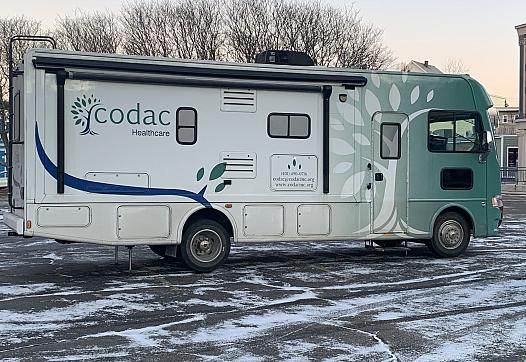Chasing the Fix: Addiction treatment on wheels
The story was originally published in The Public's Radio with the support from USC Annenberg Center for Health Journalism’s 2022 National Fellowship.
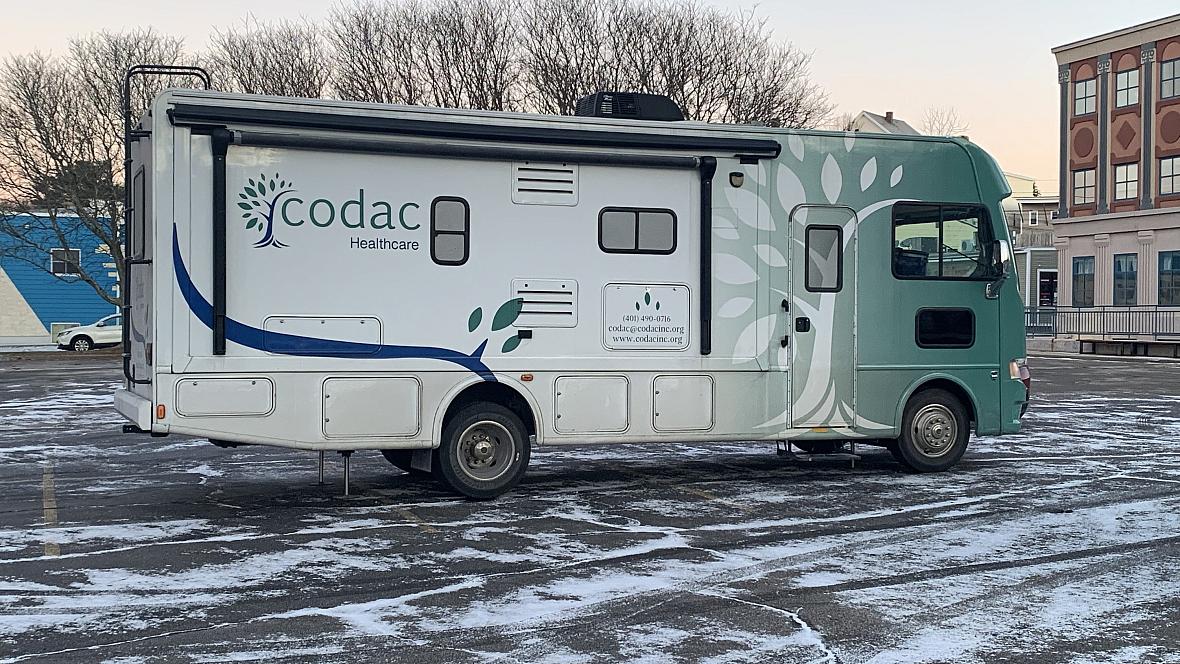
In July, CODAC Behavioral Healthcare launched one of the first mobile clinics licensed to dispense methadone in the U.S. in more than a decade
Lynn Arditi/The Public's Radio
Inside a converted RV discreetly labeled “Mobile Healthcare,’’ Neville Johnson looked out at an empty parking lot in Woonsocket, R.I. with growing frustration.
The mobile clinic was offering medications for people addicted to opioids to relieve their cravings – and their relentless search for drugs on the streets. But nearly two hours had passed on this hot July morning and Johnson hadn't seen a single patient.
The Public's Radio · Chasing the Fix: Addiction treatment on wheels
A 39-year-old nurse supervisor, Johnson had grown up poor in Bridgeport, Connecticut, during the crack epidemic. He’d lost his 28-year-old brother to a bullet over a drug deal.
Johnson wasn’t inclined to wait around. So he climbed out of the air-conditioned van, grabbed a stack of fliers and set out on foot to spread the word.
“I'm trying to get in touch with the community,’’ he said, “let them know we're out here.’’
Down the road, a group of people were gathered outside a trailer offering free showers to people living on the streets. Johnson approached a frail-looking man seated on a curb.
“How ya doin, chief?” Johnson asked.
At 43, Cory is stoop-shouldered with tattooed arms. (Cory asked to be identified by his first name, to protect his privacy). The inside of his left arm bore the telltale red marks of an IV drug user.
Johnson was just winding up for his pitch when Cory broke in: “You don't do methadone, do you?’’
Johnson replied, “We sure do!’’
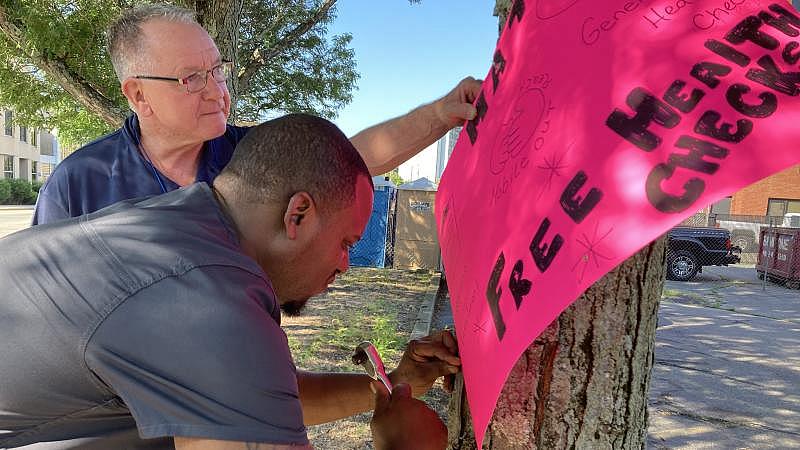
Driver John Hayes (left) helps Nurse Neville Johnson post a sign outside CODAC's mobile clinic. LYNN ARDITI/THE PUBLIC'S RADIO
‘We have to go to them’
Thirty-seven people died of drug overdoses in Woonsocket in 2021, or 85.6 per 100,000 residents, the highest rate in Rhode Island, according to state health data. Now, this former mill city of roughly 43,000 people is a testing ground for a new treatment program designed to bend the rising curve of opioid overdose deaths.
Nearly 300 Americans a day, on average, died of drug overdoses in 2021, according to the latest available data by the Centers for Disease Control and Prevention. Yet only about one in four people in this country with opioid-use disorder received one of three federally-approved medications to treat addiction, according to a 2019 study published in JAMA. And those living on the streets who need that treatment are especially hard to reach.
“The folks that need us the most have the least amount of internal resources to get to us,’’ said Linda Hurley, president and chief executive officer of the nonprofit CODAC Behavioral Healthcare, the state’s largest methadone provider. “We have to go to them.”
CODAC last July launched one of the first mobile clinics licensed to dispense methadone in the U.S. in more than a decade. The Cranston-based nonprofit is taking advantage of federal regulations published in 2021 allowing opioid treatment providers to dispense methadone from mobile clinics to expand access to care.
CODAC received a one-year $296,000 grant from the state to operate the mobile clinic in Woonsocket.
Outreach workers had hoped to drive the mobile clinic to a public park, closer to people living in tent encampments. But people close to the discussions said that idea got a cool reception from park officials. In Woonsocket, the closest brick-and-mortar methadone clinic is a 15-minute bus ride from the city’s downtown, where many of the poorest residents congregate.
For people struggling with poverty, mental illness and homelessness, Hurley said, “any travel, three blocks by foot, is hard to do.’’
“Going right to the tent encampments is where we really need to be,” Hurley said. “At the same time, we need to pay attention to how the community feels about their safety and security…So this is where we start.”
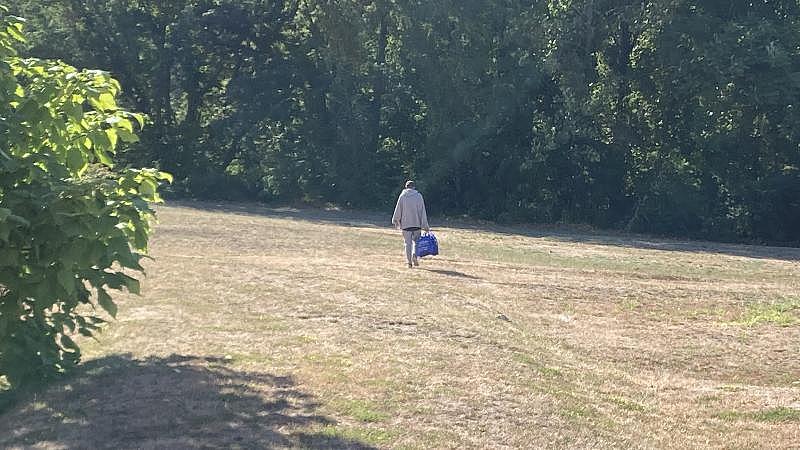
Cory heads back to his tent encampment with a bag containing naloxone and other harm reduction supplies from CODAC's mobile clinic. LYNN ARDITI/THE PUBLIC'S RADIO
‘I don't do dope to get high’
Each morning, the mobile clinic pulls into the parking lot of a local nonprofit agency and waits.
Inside the 27-foot RV, a plexiglass window separates patients from the room where a nurse dispenses medication.
Besides methadone, the clinic also offers two other federally approved medications to treat opioid addiction: Suboxone, a medicine containing buprenorphine, which blocks cravings for opioids, and Vivitrol, an injectable version of naltrexone, which blocks opioid receptors.
But it’s the methadone that could be a game changer for people like Cory. Methadone is especially effective for treating severe opioid use disorder.
When I first met Cory last July, he was living with his wife in a tent encampment on the banks of the Blackstone River. He was wiry and tanned, and seemed to boast a survivalist’s mentality. He had a filter for river water for drinking, and he’d use a watering can and a tarp he’d rigged up for privacy to shower.
He also said that he’d never overdosed. “Never, not once,” he said. “But I also don’t mix (drugs)…I don’t drink at all.”
Cory said he started smoking weed when he was 12 years old, and when he was 16 he tried heroin. By the time he was in his 30s, he was addicted to prescription opioids. Back then, he was working at a roofing company.
“I just hurt my back one too many times. Now it’s shot,” he said. “So the pain that I deal with on a daily basis is debilitating.”
A doctor had prescribed him oxycodone for chronic back pain. But after Cory showed up in a hospital emergency department in 2013 reporting pain following a hand injury, court records show, a pharmacist notified the hospital that he’d displayed “drug seeking behavior.” After doctors stopped prescribing him opioids, Cory said, he began buying drugs on the street.
“I do dope daily,’’ Cory said. “I don't do dope to get high. I do dope to function to be able to do the normal things that normal people are able to do.”
Cory also has been diagnosed with bipolar disorder, which causes extreme mood swings. He said he takes prescription medication for his condition, but usually not at his prescribed dose because it knocks him out.
Cory said that he enrolled in a drug rehab program in 2007 and did well until he got out. “As soon as I hit the streets on my own,” he said, “I ended up relapsing.” He said he went back into the program. Afterwards, he went to stay with his father in Georgia. He worked at a restaurant there, met his wife, and she came back with him to Woonsocket. (We’re not using her name to protect their privacy.)
For a time, Cory’s wife said she worked as a medical coder and they shared a rental apartment in Woonsocket. But she, too, struggled with addiction. For the past six years, she said, she has been able to manage with the help of methadone treatment.
The burden of Cory’s addiction has weighed on both of them. As Cory described it, his years of opioid use had heightened his tolerance for the drugs, creating a vicious cycle that has left him increasingly debilitated. He awakened each morning needing another fix. And his wife worked to pay for his habit.
After they were evicted from their last apartment, they lived out of the Chevy Equinox that his wife’s parents left her. But in the winter of 2021, the car died and they were homeless.
“You know, a lot of us aren't in this situation or predicament, because we chose to be or wanted to be, or even because the main part is drugs that put us here,’’ Cory said. “The reason why a lot of us get high is…so that way, we don't end up killing our f***ing selves.”
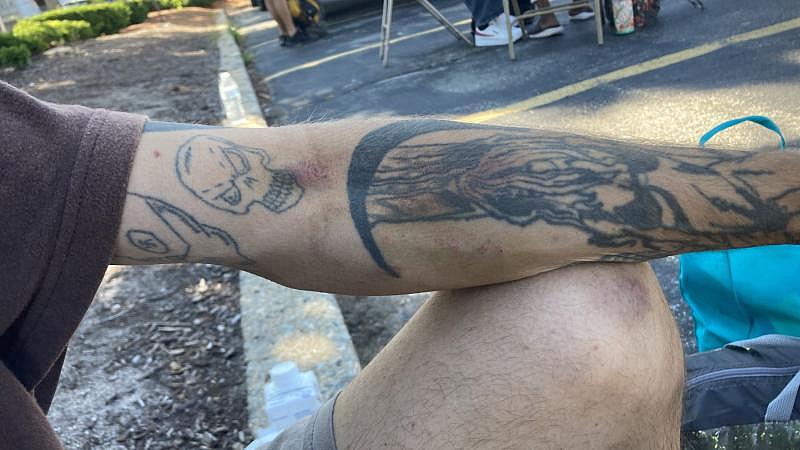
Cory shows his arm is sore from injecting fentanyl. LYNN ARDITI/THE PUBLIC'S RADIO
‘Oh Cory, where’ve you been?’
CODAC’s mobile clinic will need to enroll at least 112 patients by July 2023 — its first 12 months of operation. CODAC expects that would allow the clinic to break even after insurance reimbursements. But it gets off to a slow start.
One morning in early August, Cory was the first patient to show up.
The skin on the inside of his left arm was red and sore from needle sticks. He’d overdosed and was released the day before from Landmark Medical Center. “I shot a gram of dope in one shot,’’ Cory said. “Somebody found me on the side of the road…”
Cory said that he’d started shooting fentanyl, a cheap synthetic opioid 50 times more powerful than heroin. The federal Drug Enforcement Agency has described fentanyl as the country’s “single deadliest drug threat,’’ warning that potentially lethal doses are increasingly showing up in fake pills marketed as medications like OxyContin and Adderall.
Fentanyl also presents a challenge for CODAC’s mobile clinic. The dosing regimen for methadone means it usually takes months for someone like Cory to ramp up to the 100 milligrams or more that fentanyl users need to sate their cravings, said Dr. Catherine DeGood, CODAC’s medical director.
“Federal regulations around methadone treatment were set in the ‘70s,’’ she said, “and they have pretty much stayed the same since then.’’
The dosing regime means that Cory will continue using illicit drugs. The hope is that he’ll stay in treatment and eventually wean off the fentanyl he buys on the street.
But at the start of his second week, Cory vanished. When he didn’t show up for a second day, John Hayes, the mobile clinic’s driver, left Cory a phone message.
Hey Cory, it's John at CODAC's mobile unit over here on Clinton Street. Just wondering how you doing today and let you know we're here and I brought a few snacks down today, too, if you're interested
Four days later Cory reappeared. He climbed the steps into the van.
Johnson, the nurse supervisor who last summer recruited Cory into the CODAC program, was not at the mobile unit that day. But the nurse at the dosing window greeted him by name.
“Oh Cory, where’ve you been?’’
“It’s been a couple of days,’’ he said.
If a patient misses four consecutive doses, providers are supposed to cut their methadone by at least half.
When Cory was on methadone years ago he was up to 190 milligrams. But he seemed resigned to this setback. He knows the drill.
“We have to start all over again, OK, because you missed a couple of days, all right?” the nurse told him. “So it’s gonna be 30 (milligrams) today.”
‘I feel helpless’
By early December, the mobile clinic had enrolled about 50 patients. But on a recent Wednesday morning, Cory wasn’t there. Nor had Cory stopped by the shower trailer in Thundermist Health Center’s parking lot, where Dr. Gabriel Pleasants was making his weekly rounds with his homeless patients.
Pleasants, a family physician, declined to talk specifically about Cory. But generally speaking, he said, when patients don’t show up for treatment he worries about them.
“I feel helpless,’’ Pleasants said. “I know we're out here to provide people with the tools and treatment and to be a force for walking along whatever path they're on.”
The patients he treats who are homeless don’t have private doctors.
“So when I know I'm not able to connect with them,’’ he said, “I know that there's really no other resource, most likely that they're accessing at that time…short of the hospital.”
Pleasants said he plans to keep returning to the streets. And so do the operators of the mobile methadone clinic. The question is whether the treatment they offer will be enough to get someone like Cory through another winter without a home.
[This article was originally published by The Public's Radio.]
Click here for more stories from Chasing The Fix
This story was produced with support from the USC Annenberg Center for Health Journalism’s 2022 National Fellowship.
Health reporter Lynn Arditi can be reached at larditi@thepublicsradio.org. Follow her on Twitter @LynnArditi
Did you like this story? Your support means a lot! Your tax-deductible donation will advance our mission of supporting journalism as a catalyst for change.


